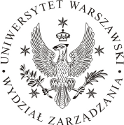Preparation of manuscripts
A. General information
To submit the paper Authors are asked to prepare in the separate documents:
- Main document without Authors information
- Title page
- Figures
- Tables
- Declaration of non-infringement of third-party copyrights
- Open Access Licence
The main document should contain the following elements (in the given order):
- Title of the issues to which the papers is submitted
- Article title
- Structured abstract (up to 250 words)
- JEL Classification (JEL Classification numbers are available here)
- Keywords (up to 5)
- Introduction, consecutive headings, conclusion(s)
- Endnotes
- References-bibliography
Title page should include Title of the issues to which the papers is submitted; Article title and information about the author:
- name and surname
- academic title/degree
- affiliation (with a detailed corresponding address)
- e-mail address
- postal address (to send copyright transfer agreement).
- orcid ID (http://orcid.org)
B. Manuscript format
The manuscript should be no longer than 20 standard typed pages (1 page = 1800 characters; Times New Roman font, font size: 12, 1.5 line spacing, margins: 2.5). In the case of book reviews, the submitted manuscript should not exceed 6 pages.
All illustrations should be clearly marked, sent in separate files, with their location in the manuscript indicated. A pdf file should include the illustrations contained in the manuscript. Please send your manuscript in the MS Word or compatible (rtf) format. If possible, figures should be prepared in Adobe Illustrator (ai) format, and their source data – in Excel 3.0 (xls). Preferred format of illustrations: Adobe Illustrator (ai). All illustrations should be black and white. If the manuscript contains photographs, please send us their originals.
Authors are responsible for obtaining necessary permits for publication of any materials under the copyright held by third parties.
C. Manuscript layout
Title page should include Title of the issues to which the papers is submitted; Article title and information about the author: name and surname, academic title/degree, affiliation (with a detailed corresponding address), e-mail address, postal address (as indicated above). Please put this information on a separate page.
The main document should contain the following elements (in the given order):
- Title of the issues to which the papers is submitted
- Article title
- Structured abstract (up to 250 words)
- JEL Classification (JEL Classification numbers are available here)
- Keywords (up to 5)
- Introduction, consecutive headings, conclusion(s)
- Endnotes
- References-bibliography
D. Endnotes, references, citations*
Any author’s endnotes should be few and short, if possible.
References should cover solely the items referred to or cited in the text, no papers cited from a secondary source should be included in the references. In each reference item the author must include its assigned DOI no. (if applicable) (http://www.crossref.org/guestquery/).
Prepare alphabetical listing of references by the first author’s surname (works by the same author should be given in the alphabetical order of the titles of works).
"Studia i Materiały" uses the APA (American Psychological Association) (6th edition) referencing system (see: http://www.apastyle.org/ or http://blog.apastyle.org/).
Citations in the text
- single author’s work: always give the author’s surname and publication date (no matter how many times the work is cited); when referring to more than one work by a given author published in the same year, add consecutive letters of the alphabet after the date (this rule also applies to the other types of publications listed below), e.g.: (Kowalski, 2001); (Kowalski, 2001a);
- a work by two authors: always give both authors’ surnames and publication date (no matter how many times the work is cited); authors’ surnames should always be connected with “and”, even in the case of foreign-language publications, e.g.: (Kowalski and Nowak, 2001); (Kowalski and Nowak, 2001a);
- a work by 3–5 authors: when citing for the first time, mention the surnames of all authors, separating them by commas and inserting “and” between the last two surnames; when citing again, mention the first author’s surname with the abbreviation “et al.”, e.g. for the first time: (Kowalski, Nowak and Jones, 2001); (Kowalski, Nowak and Jones 2001a); and then: (Kowalski et al., 2001); (Kowalski et al., 2001a);
- a work by 6 or more authors: mention the first author’s surname only (both for first and all subsequent citations), other authors should be replaced by the abbreviation “et al.”; include surnames of all authors in the references, e.g.: (Kowalski et al., 2001); (Kowalski et al., 2001a);
- citing several works simultaneously: publications should be listed alphabetically (by the first author’s surname); several works by the same author should be separated by a comma; individual publications by various authors must be separated by a semicolon, e.g.: (Kowalski, 2001; Nowak and Kowalski, 2002); (Kowalski, 2001, 2002a; Nowak and Kowalski, 2002);
- use secondary citations in the text only, the references should include only the source read; works should be separated by a semicolon, e.g.: (Kowalski, 2001; cited in Nowak 2002).
Quotations in the text should always be put in quotation marks, with the author’s/authors’ surname(s), publication year and page number as follows: (author/authors, publication year, page number), e.g.: (Kowalski, 2000, p. 67) or (Kowalski and Nowak, 2001, p. 3), or (Kowalski, Nowak and Jones, 2001a, p. 3).
E. Corrections
Should any corrections or abridgements be necessary, the manuscript will be returned to the author, who must introduce amendments within the time period specified by the Editorial Board. The Editors reserve the right to make minor linguistic adjustments and abridge the text.
